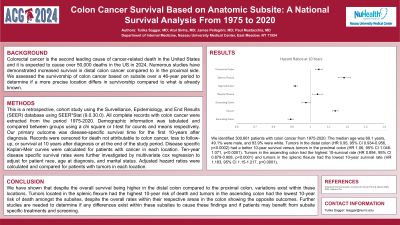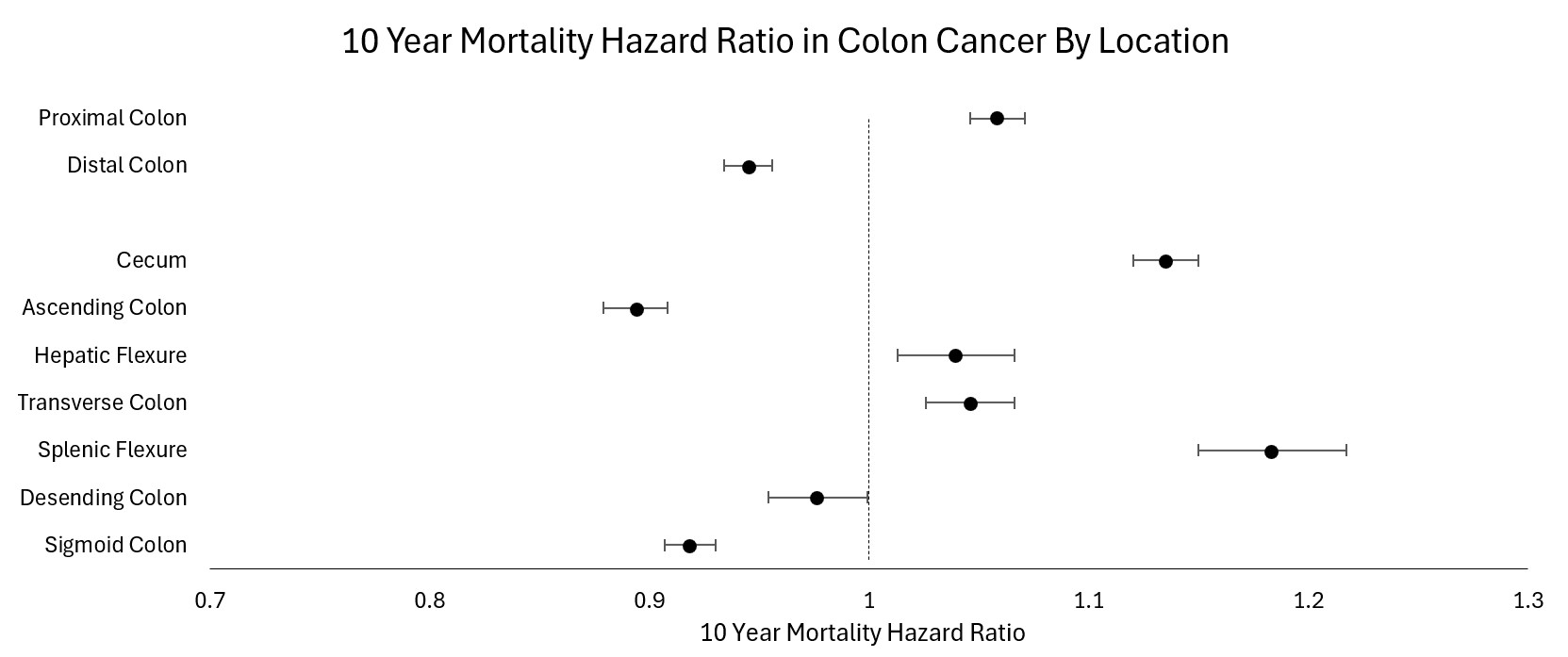Monday Poster Session
Category: Colon
P1959 - Colon Cancer Survival Based on Anatomic Subsite: A National Survival Analysis From 1975-2020
Monday, October 28, 2024
10:30 AM - 4:00 PM ET
Location: Exhibit Hall E

Has Audio

Tulika Saggar, MD
Nassau University Medical Center
East Meadow, NY
Presenting Author(s)
Tulika Saggar, MD1, Atul Sinha, MD1, James R. Pellegrini, MD2, Samuel Greenberg, BA3, Paul Mustacchia, MD, MBA1
1Nassau University Medical Center, East Meadow, NY; 2Nassau University Medical Center, Great River, NY; 3Renaissance School of Medicine at Stony Brook University, Stony Brook, NY
Introduction: Colorectal cancer is the second leading cause of cancer-related death in the United States and it is expected to cause over 50,000 deaths in the US in 2024. Numerous studies have demonstrated increased survival in distal colon cancer compared to in the proximal side. We assessed the survivorship of colon cancer based on subsite over a 46-year period to determine if a more precise location differs in survivorship compared to what is already known.
Methods: This is a retrospective, cohort study using the Surveillance, Epidemiology, and End Results (SEER) database using using SEER*Stat (9.0.30.0). All complete records with colon cancer were extracted from the period 1975-2020. Our primary outcome was disease-specific survival time for the first 10-years after diagnosis. Records were censored for death not attributable to colon cancer, loss to followup, or survival at 10 years after diagnosis or at the end of the study period. Disease-specific Kaplan-Meier curves were calculated for patients with cancer in each location. Ten-year disease specific survival rates were further investigated by multivariate cox regression to adjust for patient race and age at diagnosis. Adjusted hazard ratios were calculated and compared for patients with tumors in each location.
Results: We identified 300,661 patients with colon cancer from 1975-2020. The median age was 69.1 years, 49.1% were male, and 83.9% were white. Tumors in the distal colon (HR 0.95, 95% CI 0.934-0.956, p< 0.0002) had a better 10-year survival versus tumors in the proximal colon (HR 1.06, 95% CI 1.046-1.071, p< 0.0001) (Figure 1). Tumors in the ascending colon had the highest 10-survival rate (HR 0.894, 95% CI 0.879-0.908, p< 0.0001) and tumors in the splenic flexure had the lowest 10-year survival rate (HR 1.183, 95% CI 1.15-1.217, p< 0.0001).
Discussion: We have shown that despite the overall survival being higher in the distal colon compared to the proximal colon, variations exist within these locations. Tumors located in the splenic flexure had the highest 10-year risk of death and tumors in the ascending colon had the lowest 10-year risk of death amongst the subsites, despite the overall rates within their respective areas in the colon showing the opposite outcomes. Further studies are needed to determine if any differences exist within these subsites to cause these findings and if patients may benefit from subsite specific treatments and screening.

Disclosures:
Tulika Saggar, MD1, Atul Sinha, MD1, James R. Pellegrini, MD2, Samuel Greenberg, BA3, Paul Mustacchia, MD, MBA1. P1959 - Colon Cancer Survival Based on Anatomic Subsite: A National Survival Analysis From 1975-2020, ACG 2024 Annual Scientific Meeting Abstracts. Philadelphia, PA: American College of Gastroenterology.
1Nassau University Medical Center, East Meadow, NY; 2Nassau University Medical Center, Great River, NY; 3Renaissance School of Medicine at Stony Brook University, Stony Brook, NY
Introduction: Colorectal cancer is the second leading cause of cancer-related death in the United States and it is expected to cause over 50,000 deaths in the US in 2024. Numerous studies have demonstrated increased survival in distal colon cancer compared to in the proximal side. We assessed the survivorship of colon cancer based on subsite over a 46-year period to determine if a more precise location differs in survivorship compared to what is already known.
Methods: This is a retrospective, cohort study using the Surveillance, Epidemiology, and End Results (SEER) database using using SEER*Stat (9.0.30.0). All complete records with colon cancer were extracted from the period 1975-2020. Our primary outcome was disease-specific survival time for the first 10-years after diagnosis. Records were censored for death not attributable to colon cancer, loss to followup, or survival at 10 years after diagnosis or at the end of the study period. Disease-specific Kaplan-Meier curves were calculated for patients with cancer in each location. Ten-year disease specific survival rates were further investigated by multivariate cox regression to adjust for patient race and age at diagnosis. Adjusted hazard ratios were calculated and compared for patients with tumors in each location.
Results: We identified 300,661 patients with colon cancer from 1975-2020. The median age was 69.1 years, 49.1% were male, and 83.9% were white. Tumors in the distal colon (HR 0.95, 95% CI 0.934-0.956, p< 0.0002) had a better 10-year survival versus tumors in the proximal colon (HR 1.06, 95% CI 1.046-1.071, p< 0.0001) (Figure 1). Tumors in the ascending colon had the highest 10-survival rate (HR 0.894, 95% CI 0.879-0.908, p< 0.0001) and tumors in the splenic flexure had the lowest 10-year survival rate (HR 1.183, 95% CI 1.15-1.217, p< 0.0001).
Discussion: We have shown that despite the overall survival being higher in the distal colon compared to the proximal colon, variations exist within these locations. Tumors located in the splenic flexure had the highest 10-year risk of death and tumors in the ascending colon had the lowest 10-year risk of death amongst the subsites, despite the overall rates within their respective areas in the colon showing the opposite outcomes. Further studies are needed to determine if any differences exist within these subsites to cause these findings and if patients may benefit from subsite specific treatments and screening.

Figure: Figure 1: 10-year mortality hazard ratio in colon cancer by location
Disclosures:
Tulika Saggar indicated no relevant financial relationships.
Atul Sinha indicated no relevant financial relationships.
James Pellegrini indicated no relevant financial relationships.
Samuel Greenberg indicated no relevant financial relationships.
Paul Mustacchia indicated no relevant financial relationships.
Tulika Saggar, MD1, Atul Sinha, MD1, James R. Pellegrini, MD2, Samuel Greenberg, BA3, Paul Mustacchia, MD, MBA1. P1959 - Colon Cancer Survival Based on Anatomic Subsite: A National Survival Analysis From 1975-2020, ACG 2024 Annual Scientific Meeting Abstracts. Philadelphia, PA: American College of Gastroenterology.
